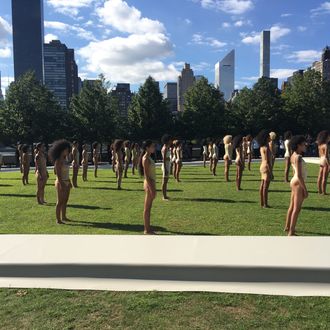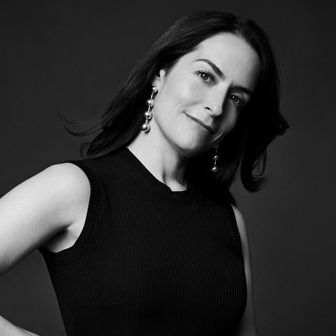
I woke up yesterday morning thinking about how Yeezy Season 4 might be the most exciting thing I would attend all week — and by “exciting” I mean irreverent, original, provocative, memorable. I loved Kanye’s show last season at Madison Square Garden: the spectacle, the pomposity. I loved Kanye’s gravitational pull and how we were all sucked in. I loved watching Anna Wintour sit with the Kardashians. I loved feeling like an insignificant extra, like the fashion world was outnumbered, as he played his unfinished album and talked through his insecurities. It was massive and yet intimate, bigger than fashion, and it felt like Kanye made the season more interesting by forcing us to contend with him.
The Roosevelt Island show was something else entirely: an hours-long process that took us to a remote location, to witness what felt like a torture session for a bunch of civilian models, and a terrible experience of feeling complicit in enabling the situation. I expressed this on Twitter and spent the rest of the night being bombarded by hateful tweets. I thought it might be better not to write about Yeezy Season 4, but I think the experience deserves explanation.
The day started with a long bus ride to Roosevelt Island, where editors learned that the show would be held at the crumbling monument of a hospital that once housed smallpox victims. Fitting, we joked, all a little overheated but poking fun at ourselves for our willingness to suffer for fashion. We didn’t know what to expect and we tend to like that.
On the other side of the monument was a stark concrete staircase. At the top, a long grass plateau. Standing in lines as if waiting to be sacrificed were row upon row of street-cast extras, clad in small scraps of “nude” Lycra and arranged in order from lightest skin to darkest skin. It wasn’t clear how long they had been standing in this formation, but they already looked too hot. The show was running an hour behind. To his credit Kanye included darker-skinned models, despite concerns that his casting call for “multiracial” models meant excluding them. All of this was in keeping with the aesthetic of Kanye’s frequent collaborator Vanessa Beecroft, who sees skin color as paint chips and women as props.
Nothing happened. For 15 minutes or so we watched as one by one the street-cast models kneeled in what looked like exhaustion. Part of the plan, I thought. Music droned, mixing with the disconcerting sound of a helicopter circling overhead. Anna Wintour arrived. The Kardashians arrived. Another model wilted. More models sat down.
“Must be choreographed,” the woman sitting next to me said.
“I wonder if we have to wait for them all to sit down and then it will be over?” another person standing behind me suggested.
On the far opposite side of where I was seated, a model appeared to actually faint. She came to and stood up, only to crumple again. “Did she faint!?” people around me wondered out loud. Another girl standing next to her helped prop her up. No one in the audience did anything. No one producing the show rushed to help her. A few minutes later, a woman wearing a head mic brought some water. Another model went down. Eventually a man in the front row gave her his water.
At this point something shifted for me internally: This didn’t feel like a good situation. I’ve seen my share of fainting models at shows. The last time it happened, at a Rosie Assoulin show, several onlookers ran to help her and the paramedics were called. Watching a model fall or faint is always upsetting, calling to mind the grueling physical nature of their work, the starvation, the expectations that they walk in clothing that hobbles them. This felt worse than usual because these women were not professionals. Due to the performance elements of the whole spectacle, we were all genuinely confused as to whether the models’ collapsing had been planned or not. It didn’t seem planned.
Then, at last, the “real” models — that is to say, the professionals, the famous ones — began to walk out in the “looks,” white thigh-high boots and sweatshirts. All of the anonymous “extras” who had been baking in the hot sun rallied and stood up again and stared forward.
A model clad entirely in black rounded the runway in boots, looking perilously unstable. She moved three steps and stopped, her ankles appearing to give out beneath her. She took three more steps, stopped, making her way slowly and holding up the show. It wasn’t clear if she was ill or her boots made her unable to walk. It wasn’t clear if it was part of the performance, but it was disturbing to witness. A few editors fled. A strange rage and anxiety began creeping through my body.
“Why is no one helping her?!” I asked. Should I have been helping her? Should I get up and make myself part of the show? Was it possible that this was part of the show? Maybe Kanye was pranking us all, or conducting some grand social experiment about the fashion industry’s lack of empathy — a Yeezy take on the Milgram experiments.
“It’s fucking beautiful,” said the woman next to me. “It’s the most beautiful thing in the whole show.” I tried to ignore her. Farther down the row, people made rude comments about how the models were failing and how “they should have eaten more.” The pressure to sit there in silence was intense. As I was about to get up, a man finally came to the model’s rescue and helped her walk the rest of the runway. It was nearly 5 p.m. I couldn’t take it any longer and left before the show ended. I felt terrible for watching this go down. As I passed Vanessa Friedman of the New York Times, also leaving, she said, “Joke’s on us.”
Perhaps. But none of it was funny. I’ve gone to every Yeezy show. The first time he showed a group of street-cast models it felt refreshing, a celebration of different kinds of beauty and body types, which is something the industry needs. It was even possible to pretend there was a bigger message in Season 3’s Madison Square Garden event — a commentary about globalism and consumption.
This time, though, there was a stark contrast between the street-cast models silently falling before our eyes and their agency-repped counterparts, who were not standing naked in the sun until it was time for them to walk. A generous interpretation would have it that Kanye was making a point about beauty hierarchies, but if he had an agenda, it was too obscure for the audience to pick up on it. Maybe he and Beecroft will clarify the effect they were going for. But it seems simpler and more likely that they just didn’t think much about what might happen if young women were forced to stand in the hot sun for a long time, and didn’t have a team that was able to act in an empathetic way when they became unwell.


